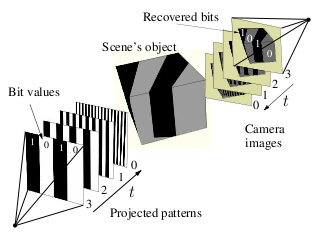Abstract

Multimedia projectors and cameras make possible the use of structured light to solve problems such as 3D reconstruction, disparity map computation and camera or projector calibration. Each projector displays patterns over a scene viewed by a camera, thereby allowing automatic computation of camera-projector pixel correspondences. This paper introduces a new algorithm to establish this correspondence in difficult cases of image acquisition. A probabilistic model formulated as a Markov Random Field uses the stripe images to find the most likely correspondences in the presence of noise. Our model is specially tailored to handle the unfavorable projector-camera pixel ratios that occur in multiple-projector single-camera setups. For the case where more than one camera is used, we propose a robust approach to establish correspondences between the cameras and compute an accurate disparity map. To conduct experiments, a ground truth was first reconstructed from a high quality acquisition. Various degradations were applied to the pattern images which were then solved using our method. The results were compared to the ground truth for error analysis and showed very good performances, even near depth discontinuities.
Documents
